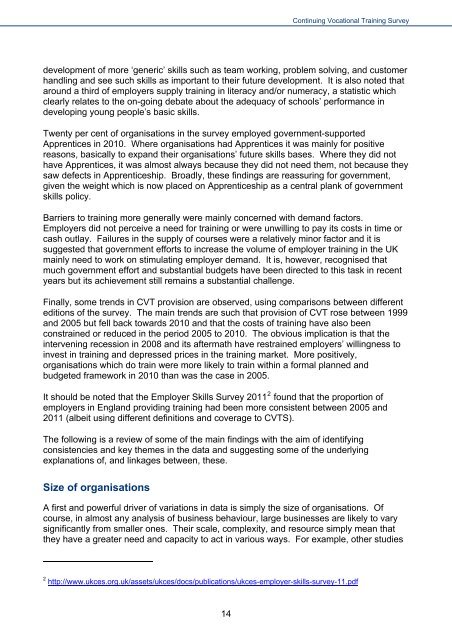bis-13-587-continual-vocational-training-survey-cvts4
bis-13-587-continual-vocational-training-survey-cvts4
bis-13-587-continual-vocational-training-survey-cvts4
Create successful ePaper yourself
Turn your PDF publications into a flip-book with our unique Google optimized e-Paper software.
Continuing Vocational Training Survey<br />
development of more ‘generic’ skills such as team working, problem solving, and customer<br />
handling and see such skills as important to their future development. It is also noted that<br />
around a third of employers supply <strong>training</strong> in literacy and/or numeracy, a statistic which<br />
clearly relates to the on-going debate about the adequacy of schools’ performance in<br />
developing young people’s basic skills.<br />
Twenty per cent of organisations in the <strong>survey</strong> employed government-supported<br />
Apprentices in 2010. Where organisations had Apprentices it was mainly for positive<br />
reasons, basically to expand their organisations’ future skills bases. Where they did not<br />
have Apprentices, it was almost always because they did not need them, not because they<br />
saw defects in Apprenticeship. Broadly, these findings are reassuring for government,<br />
given the weight which is now placed on Apprenticeship as a central plank of government<br />
skills policy.<br />
Barriers to <strong>training</strong> more generally were mainly concerned with demand factors.<br />
Employers did not perceive a need for <strong>training</strong> or were unwilling to pay its costs in time or<br />
cash outlay. Failures in the supply of courses were a relatively minor factor and it is<br />
suggested that government efforts to increase the volume of employer <strong>training</strong> in the UK<br />
mainly need to work on stimulating employer demand. It is, however, recognised that<br />
much government effort and substantial budgets have been directed to this task in recent<br />
years but its achievement still remains a substantial challenge.<br />
Finally, some trends in CVT provision are observed, using comparisons between different<br />
editions of the <strong>survey</strong>. The main trends are such that provision of CVT rose between 1999<br />
and 2005 but fell back towards 2010 and that the costs of <strong>training</strong> have also been<br />
constrained or reduced in the period 2005 to 2010. The obvious implication is that the<br />
intervening recession in 2008 and its aftermath have restrained employers’ willingness to<br />
invest in <strong>training</strong> and depressed prices in the <strong>training</strong> market. More positively,<br />
organisations which do train were more likely to train within a formal planned and<br />
budgeted framework in 2010 than was the case in 2005.<br />
It should be noted that the Employer Skills Survey 2011 2 found that the proportion of<br />
employers in England providing <strong>training</strong> had been more consistent between 2005 and<br />
2011 (albeit using different definitions and coverage to CVTS).<br />
The following is a review of some of the main findings with the aim of identifying<br />
consistencies and key themes in the data and suggesting some of the underlying<br />
explanations of, and linkages between, these.<br />
Size of organisations<br />
A first and powerful driver of variations in data is simply the size of organisations. Of<br />
course, in almost any analysis of business behaviour, large businesses are likely to vary<br />
significantly from smaller ones. Their scale, complexity, and resource simply mean that<br />
they have a greater need and capacity to act in various ways. For example, other studies<br />
2 http://www.ukces.org.uk/assets/ukces/docs/publications/ukces-employer-skills-<strong>survey</strong>-11.pdf<br />
14

















